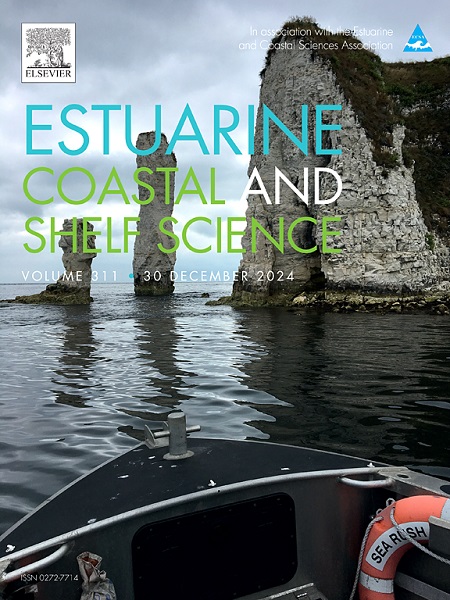马尼拉蛤(Ruditapes philippinarum)中溶解氮唑酸和腹泻贝类毒素的差异积累:温度和组织特异性摄取的影响
IF 2.6
3区 地球科学
Q1 MARINE & FRESHWATER BIOLOGY
引用次数: 0
摘要
腹泻性贝类毒素(DSTs)和氮唑酸(AZAs)是由有毒鞭毛藻产生的亲脂性贝类毒素,已知对贝类消费者构成重大风险。本研究研究了溶解的AZA2、冈田酸(OA)和甲藻毒素-1 (DTX1)在马尼拉蛤(Ruditapes philippinarum)中的组织特异性摄取、积累和保留。马尼拉蛤以有毒鞭毛藻为食,其消化腺中AZA2显著积累。另一方面,溶解的AZA2在鳃中大量积累,并表现出较强的组织保留。马尼拉蛤在其所有组织的消化腺中只积累了微量的溶解OA和DTX1。这些结果表明,马尼拉蛤对AZAs和DSTs的摄取机制不同。温度显著影响溶解AZA2的吸收,在温暖的条件下积累量较高,有利于马尼拉蛤的活动。这些发现首次对马尼拉蛤对溶解AZAs和DSTs的吸收进行了比较分析,强调了它们在环境毒素监测和食品安全风险评估中的潜在作用。本文章由计算机程序翻译,如有差异,请以英文原文为准。

Differential accumulation of dissolved azaspiracids and diarrhetic shellfish toxins in Manila clam (Ruditapes philippinarum): effects of temperature and tissue-specific uptake
Diarrhetic shellfish toxins (DSTs) and azaspiracids (AZAs) are lipophilic shellfish toxins produced by toxic dinoflagellates and known to pose significant risks to shellfish consumers. This study investigates tissue-specific uptake, accumulation and retention of dissolved AZA2, okadaic acid (OA), and dinophysistoxin-1 (DTX1) in Manila clam (Ruditapes philippinarum). Manila clam feeding on toxic dinoflagellate showed significant accumulation of AZA2 in the digestive glands. On the other hand, dissolved AZA2 was accumulated significantly in the gills and showed strong tissue retention. Manila clam accumulated only trace levels of the dissolved OA and DTX1 in the digestive glands in all of its tissues. These results suggested that Manila clam had different uptake mechanisms for AZAs and DSTs. Temperature significantly influenced dissolved AZA2 uptake, with higher accumulation at warmer conditions conducive to Manila clam activity. These findings offer the first comparative analysis of dissolved AZAs and DSTs uptake in Manila clam, highlighting their potential role in environmental toxin monitoring and food safety risk assessment.
求助全文
通过发布文献求助,成功后即可免费获取论文全文。
去求助
来源期刊
CiteScore
5.60
自引率
7.10%
发文量
374
审稿时长
9 months
期刊介绍:
Estuarine, Coastal and Shelf Science is an international multidisciplinary journal devoted to the analysis of saline water phenomena ranging from the outer edge of the continental shelf to the upper limits of the tidal zone. The journal provides a unique forum, unifying the multidisciplinary approaches to the study of the oceanography of estuaries, coastal zones, and continental shelf seas. It features original research papers, review papers and short communications treating such disciplines as zoology, botany, geology, sedimentology, physical oceanography.

 求助内容:
求助内容: 应助结果提醒方式:
应助结果提醒方式:


